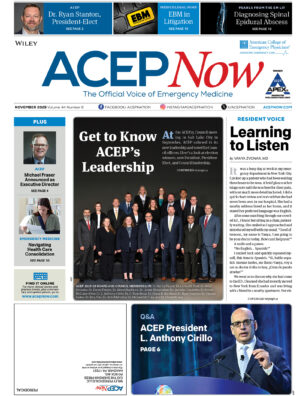A physician acquaintance of mine is on a mission to promote awareness, especially in emergency physicians, of the potential for post-traumatic stress disorder in children who have been attacked and/or bitten by dogs. Thus this blog post. As a practicing psychiatrist, he has treated a number of such children, and he believes it is very important for physicians who are treating these children for their bite wounds to inform parents to actively watch for signs of PTSD and to get evaluation and treatment if indicated. He has lectured and published on this topic (Larry Schmitt, MD, Dog bites in children: Focus on posttraumatic stress disorder, Contemporary Pediatrics, Jul 1, 2011). and makes a good case for parents and pediatricians to monitor these children closely after their injury, and for incorporating information about PTSD into post-treatment ED and inpatient discharge instructions.
Explore This Issue
ACEP News: Vol 31 – No 11 – November 2012One may not readily consider the diagnosis of PTSD in children, but after dog bites it appears that children pick up on the guilt and sadness in their parents’ faces, and tend to bury their feelings and avoid discussion of the attack. This of course may precipitate PTSD, and make it more difficult to identify this pathology unless one recognizes the symptoms (excessive anxiety, irritability, decreased school performance, sleep disturbance, reduced creativity, withdrawal, altered appetite, depression, physical complaints, pronounced startle responses, and behavior problems), and relates them back to the attack. Parents need to know how to recognize PTSD, and also how to mitigate the chance of their child developing PTSD. Preemptive psychological management is likely to be helpful, and parents need to participate in helping their children cope.
One article I reviewed suggested that children need to be helped to understand the following:
- Many children become fearful whenever they have reminders of the incident, such as seeing other dogs or even watching movies/TV shows with dogs.
- They may feel more nervous when they leave their house, fearing they may be attacked and bitten again by a dog.
- They may experience depressive symptoms, such as feelings of helplessness, frustration, and diminished social and/or educational functioning; but these feelings are not a sign of weakness. Rather, they are a foreseeable reaction to having been bitten.
Emergency physicians treat a lot of children with dog bites, and they have an important role beyond caring for the injuries themselves. Making parents aware of the potential for PTSD, providing information about signs and symptoms of PTSD in written dog-bite discharge instructions, and suggesting referrals for preemptive psychological counseling can all make a significant contribution to the child’s recovery from this kind of trauma.
(This blog is reprinted with permission from www.ficklefinger.net/blog/)
Pages: 1 2 | Multi-Page





One Response to “PTSD in Children After Dog Bites”
July 12, 2025
EstherMost children are bitten by the family dog. Do you REALLY think the parents are more concerned about their child’s PTSD than keeping the dog IN THE HOUSE with the defenseless child? Convincing parents to be MORE concerned about their own offspring than that of another species is one of the toughest conversations to have with a victims parents.